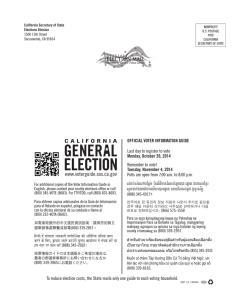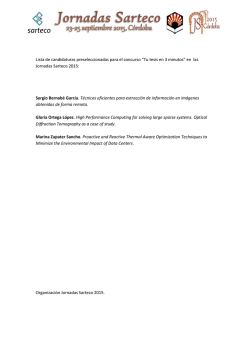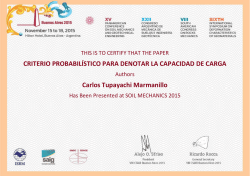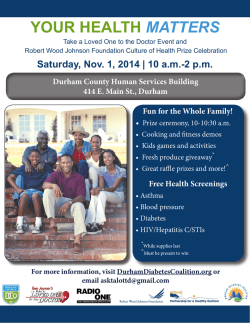
“ten island challenge”: informacion general - APC
“TEN ISLAND CHALLENGE”: INFORMACION GENERAL The Ten Island Challenge es una oportunidad para que San Andrés, Providencia y Santa Catalina definan y hagan realidad su visión de una economía limpia Nuestra Meta/Misión es la de acelerar las oportunidades comerciales para la transición de las economías de las Islas basadas en el petróleo a modelos sostenibles y crear prototipos para otras economías aisladas Resultados esperados: • Establecido un mercado de inversiones competitivo para energías renovables en los países participantes • Definido un prototipo para modelos a gran escala de energías renovables 8 ENFOQUE INTEGRADO Evaluacion Panorama • Develop a comprehensive fact base on conventional and renewable supply options including their current costs, cost trajectories, feasibility, and risks. • Understand current utility business model, threats, opportunities, and barriers to change. Analisis Technico • Consider a spectrum of energy supply and demand reduction options that will lead to the best outcome for San Andrés & Providencia by integrating understanding of current grid capabilities and best dispatching strategies. • Identify three to four options that span the spectrum from current operations to high penetrations of renewable energy and energy efficiency to understand the financial and technical implications of each scenario. Estrategia & Plan de Negocios • Design an Energy Transition Strategy whose key components will include the technical, financial, and business model solutions for the transition. • Facilitate regulatory alignment and stakeholder engagement to inform the strategic plan as it is developed and refined. HOJA DE RUTA DE LA OPORTUNIDAD COMPARACIÓN DE COSTOS Costo nivelado de la Electricidad en ($/kWh) $0,50 Costos comparativos de energías en San Andrés, Providencia y Santa Catalina Alto $0,25 Costo de Generación Medio Bajo $0.08 $0.10 Costo de eficiencia energética Costo de D&C* $0,00 Diesel LNG Wind -$0,25 -$0,50 * Costo de Sub Transmisión, Distribución y Comercialización de Energía Solar Ahorros netos como resultado de medidas de eficiencia energética Efficiency OPORTUNIDAD para Ahorrar USD$3 Billones Costos de energía a futuro (Transporte y Energía): USD 6.2 billones entre 2015 a 2030 Renovables Providencia y Modernización de Alumbrado Público 125,00 Planta RSU Transformación Hospitales Otros Miles de barriles por año 100,00 Residencial Modernización de la Red Modernización Alumbrado Público San Andrés Programa de eficiencia Residencial Programa de eficiencia Comercial 75,00 Solar 50,00 Comercial Eólico 25,00 0,00 Current Energy Use Planned Projects Remaining Energy Use Increase Building Efficiency Deploy Renewables Remaining Oil Use Hoja de Ruta para alcanzar un escenario de 80% de reducción de consumo de combustible Fósil 3 IN IN TA ROC RBON CA MOUN KY STIT UTE W AR ROO M FURTHER, FASTER, TOGETHER GRACIAS Los detailes: Justin Locke, [email protected] 7 FIRST REITERATION 1 Set goals. Gather stakeholders to set goals for what they hope to achieve for an energy transition and confirm their role in and commitment to the process. 2 Understand energy system. Gather and identify information related to current energy system, baseline scenario. 3 Determine demand-side resource potential. Conduct and gather information related to future demand-side impacts on the current energy system and load forecast. 4 Assess feasibility of renewables. Complete a feasibility study to assess the renewable energy (e.g., wind and solar) development potential on the island. The study considers such factors as quality of the renewable resource, terrain features/ complexity, compatibility with existing and future land uses, proximity to electrical infrastructure, environmental and community acceptance factors, constructability logistics, and others. 8 FIRST REITERATION 5 6 7 Develop and run least cost scenarios. Using data and metrics gathered previously, utilize a system software (HOMER Energy) to analyze potential scenarios and those that beat forecasted diesel generation costs. Scenarios can be up to the 100,000 depending on the resource potential and limitations. Complete detailed steady state, dynamic, and transient studies on the distribution and transmission grids. Model the entire distribution grid, then conduct a base case steady state analysis to determine the amount of distributed generation potential on the existing feeders/circuits. Modeled distribution generation is then aggregated to the transmission system, which is then further modeled under dynamic and transient conditions to evaluate impacts on the stability of the system for select least-cost RE penetrations and loads. Align knowledge and provide feedback into least cost scenarios. Convene a key stakeholder dialogue to provide feedback and reiteration into the least cost scenarios analyzed. 9 SECOND REITERATION 8 9 10 Refine least-cost scenarios with existing grid conditions. With feedback from the key stakeholders and understanding of current grid conditions, rerun leas-cost scenarios in the software to determine which scenarios still work under those conditions. Evaluate power production and operational implications of the least-cost scenarios. We will complete power simulations of the proposed least-cost scenarios to evaluate the impacts of the RE scenarios on the diesel generation dispatch and operation, fuel costs, overall power costs, and reliability. Results from this analysis may alter the ultimate list of scenarios that can reliably be considered after studying the distribution, transmission and power simulations of the system. financial feasibility of least cost scenarios. Building on Determine to the step previously, evaluate under different business and ownership models the most financial feasible scenarios from different stakeholder views. 10 THIRD REITERATION 11 12 Select a least-cost scenario as the Energy Transition Pathway. With key stakeholders, utilize the criteria and goals set forth in the beginning to evaluate which least-cost scenarios offer the best energy transition pathway. Adapt grid code for the Pathway. Develop standards, operational guidelines and codes related to pathway to ensure compliance. 13 Identify additional regulations that enable the Pathway. Ensure that other regulatory mechanisms are in place to support and enable the pathway moving forward. 14 Create strategy and investment plan. Develop a development and investment plan that ensures action and strategy towards how to move the Energy Transition Pathway forward. 15 Seek plan approval. Seek approval from key stakeholders and public processes to ensure that plan is equitable and reliable.
© Copyright 2025




